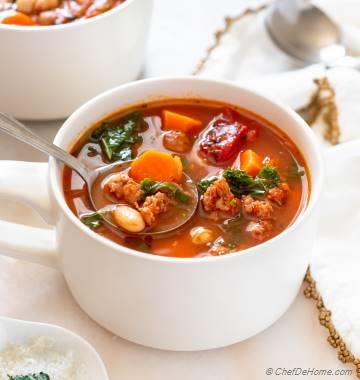A plant from tropical and subtropical regions that's grown for its gnarled and bumpy root. Most ginger comes from Jamaica, followed by India, Africa and China. Gingerroot's name comes from the Sanskrit word for 'horn root,' undoubtedly referring to its knobby appearance. It has a tan skin and a flesh that ranges in color from pale greenish yellow to ivory. The flavor is peppery and slightly sweet, while the aroma is pungent and spicy. This extremely versatile root has long been a mainstay in Asian and Indian cooking and found its way early on into European foods as well. The Chinese, Japanese and East Indians use fresh gingerroot in a variety of forms—grated, ground and slivered—in many savory dishes. Europeans and most Americans, however, are more likely to use the dried ground form of ginger, usually in baked goods. Fresh ginger is available in two forms—young and mature. Young ginger, sometimes called spring ginger, has a pale, thin skin that requires no peeling. It's very tender and has a milder flavor than its mature form. Young ginger can be found in most Asian markets in the springtime. Mature gingerhas a tough skin that must be carefully peeled away to preserve the delicate, most desirable flesh just under the surface. Look for mature ginger with smooth skin (wrinkled skin indicates that the root is dry and past its prime). It should have a fresh, spicy fragrance. Fresh unpeeled gingerroot, tightly wrapped, can be refrigerated for up to three weeks and frozen for up to six months. To use frozen ginger, slice off a piece of the unthawed root and return the rest to the freezer. Place peeled gingerroot in a screw-top glass jar, cover with dry sherry or madeira and refrigerate up to three months. The wine will impart some of its flavor to the ginger -- a minor disadvantage to weigh against having peeled ginger ready and waiting. On the plus side, the delicious ginger-flavored wine can be reused for cooking. The flavor of dried ground ginger is very different from that of its fresh form and is not an appropriate substitute for dishes specifying fresh ginger. It is, however, delicious in many savory dishes such as soups, curries and meats, a sprightly addition to fruit compotes, and indispensable in sweets like gingerbread, gingersnaps and many spice cookies. Ginger is the flavor that has long given the popular beverages ginger ale and ginger beer their claim to fame. In addition to its fresh and dried ground forms, ginger comes in several other guises. Ginger juice is simply the juice extracted from the root. It's available in some specialty markets and natural food stores. Crystallized or candied ginger has been cooked in a sugar syrup and coated with coarse sugar. Another form called preserved ginger has been preserved in a sugar-salt mixture. These types of ginger can be found in Asian markets and many supermarkets. They are generally used as a confection or added to desserts. Melon and preserved ginger are a classic combination. Pickled ginger, available in Asian markets and many supermarkets, has been preserved in sweet vinegar. It's most often used as a garnish for Asian dishes. The sweet red candied ginger is packed in a red sugar syrup. It's used to flavor dishes both sweet and savory.
From The Food Lover's Companion, Fourth edition by Sharon Tyler Herbst and Ron Herbst. Copyright © 2007, 2001, 1995, 1990 by Barron's Educational Series, Inc.
Ginger
Posted In: Food Ingredients
| Author:
Savita
Photo Credit: http://gardening.sheknows.com




